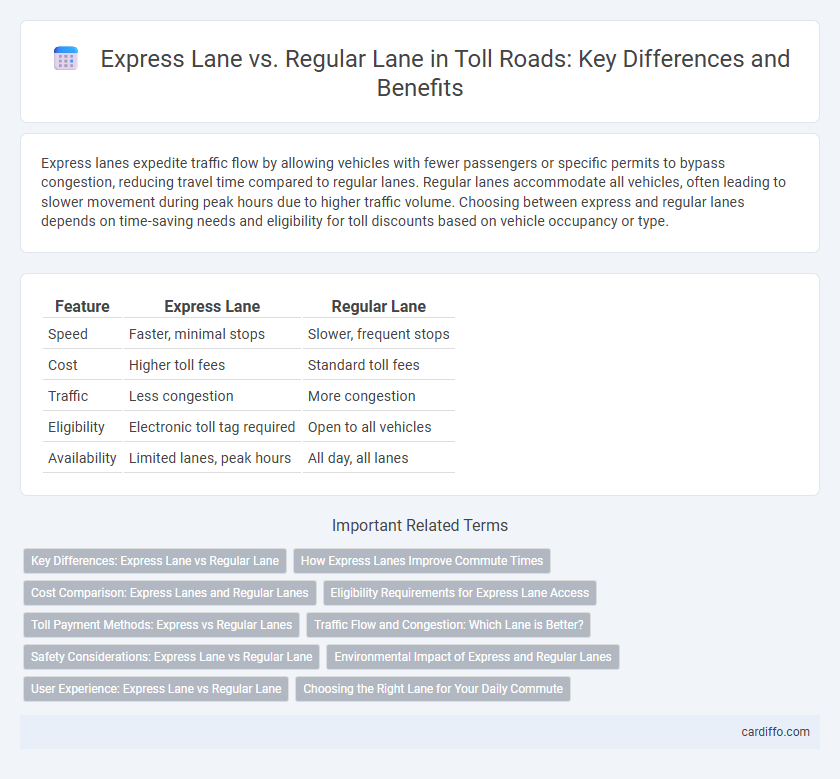Express lanes expedite traffic flow by allowing vehicles with fewer passengers or specific permits to bypass congestion, reducing travel time compared to regular lanes. Regular lanes accommodate all vehicles, often leading to slower movement during peak hours due to higher traffic volume. Choosing between express and regular lanes depends on time-saving needs and eligibility for toll discounts based on vehicle occupancy or type.
Table of Comparison
| Feature | Express Lane | Regular Lane |
|---|---|---|
| Speed | Faster, minimal stops | Slower, frequent stops |
| Cost | Higher toll fees | Standard toll fees |
| Traffic | Less congestion | More congestion |
| Eligibility | Electronic toll tag required | Open to all vehicles |
| Availability | Limited lanes, peak hours | All day, all lanes |
Key Differences: Express Lane vs Regular Lane
Express lanes provide faster travel by using electronic toll collection systems, allowing vehicles to bypass cash payment queues, which significantly reduces congestion. Regular lanes require manual toll payments, often leading to longer wait times and slower traffic flow during peak hours. Choosing express lanes enhances efficiency, especially for commuters prioritizing time savings and convenience.
How Express Lanes Improve Commute Times
Express lanes reduce commute times by limiting access to vehicles with electronic toll tags or high-occupancy vehicles, improving traffic flow and decreasing congestion compared to regular lanes. Dynamic pricing in express lanes adjusts toll rates based on real-time demand, encouraging off-peak travel and maximizing road capacity. Studies show that express lanes can cut travel time by up to 25%, providing more reliable and predictable commutes for drivers.
Cost Comparison: Express Lanes and Regular Lanes
Express lanes typically incur higher fees compared to regular lanes due to their congestion pricing model, which charges variable toll rates based on traffic demand. Regular lanes maintain a fixed toll rate or may be toll-free, making them more cost-effective for budget-conscious drivers who can tolerate potential delays. Choosing between express and regular lanes involves weighing the trade-off between time savings and toll expenses, with express lanes benefiting commuters seeking faster travel during peak hours.
Eligibility Requirements for Express Lane Access
Express Lane access eligibility requires vehicles to meet specific criteria such as occupancy minimums for carpools, designated vehicle types like motorcycles or electric cars, or possession of a valid electronic toll transponder linked to a prepaid account. Regular Lanes allow all vehicles regardless of occupancy or special vehicle classifications but may incur standard toll charges without eligibility restrictions. Verification systems and signage at toll plazas enforce eligibility to ensure efficient traffic flow and toll compliance within Express Lanes.
Toll Payment Methods: Express vs Regular Lanes
Express lanes use electronic toll collection systems such as RFID transponders or license plate recognition for seamless, cashless toll payments, reducing wait times and enhancing traffic flow. Regular lanes accept cash, coins, and credit/debit cards at toll booths, allowing manual processing but typically causing longer delays during peak hours. Choosing express lanes benefits frequent travelers by providing faster, automated toll payment without stopping, whereas regular lanes accommodate occasional users preferring traditional payment methods.
Traffic Flow and Congestion: Which Lane is Better?
Express lanes significantly improve traffic flow by allowing a limited number of vehicles to bypass regular congestion, resulting in faster travel times during peak hours. Regular lanes often experience heavy congestion and stop-and-go traffic, causing delays and increased vehicle emissions. Choosing the express lane reduces overall travel time, enhances road capacity, and helps manage traffic demand more efficiently.
Safety Considerations: Express Lane vs Regular Lane
Express lanes typically feature reduced traffic congestion and higher speed limits, which can improve traffic flow but may increase the risk of accidents due to higher speeds and merging conflicts. Regular lanes offer more controlled speeds and frequent entry and exit points, enhancing safety by minimizing abrupt lane changes and merging at high speeds. Safety considerations in choosing between express and regular lanes should balance the benefits of faster travel against the potential hazards associated with speed and traffic density.
Environmental Impact of Express and Regular Lanes
Express lanes reduce traffic congestion by promoting smoother traffic flow and minimizing idling times, which significantly lowers vehicle emissions compared to regular lanes. Regular lanes often experience stop-and-go traffic, increasing fuel consumption and greenhouse gas emissions due to prolonged engine operation. Implementing express lanes contributes to improved air quality and reduced carbon footprint in urban areas by enhancing overall transportation efficiency.
User Experience: Express Lane vs Regular Lane
Express lanes significantly enhance user experience by reducing wait times and providing seamless traffic flow through electronic toll collection systems like E-ZPass or FasTrak, minimizing the need for stopping and manual payment. Regular lanes, while more accessible for those without transponders, often experience congestion and longer delays due to cash transactions or manual ticketing, impacting convenience and travel time. Users prioritize express lanes for efficiency and consistent travel speed, especially during peak hours or high-traffic conditions.
Choosing the Right Lane for Your Daily Commute
Choosing the right lane for your daily commute can significantly impact travel time and toll costs. Express lanes often require electronic toll payment and offer faster, congestion-free travel compared to regular lanes that accommodate all vehicles but may experience delays. Evaluating traffic patterns and your payment method will help optimize your commute efficiency on toll roads.
Express Lane vs Regular Lane Infographic

 cardiffo.com
cardiffo.com